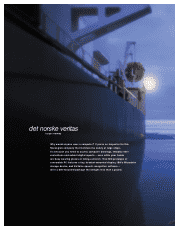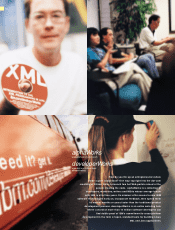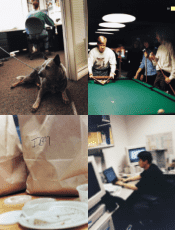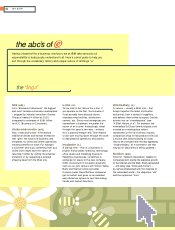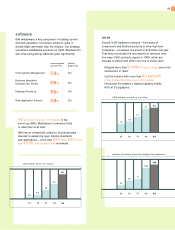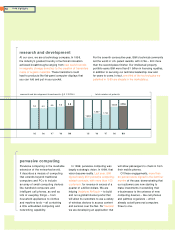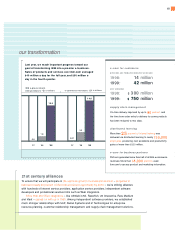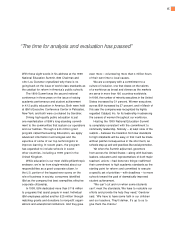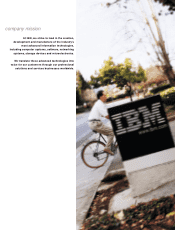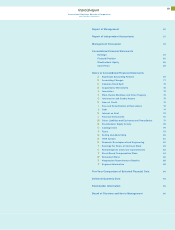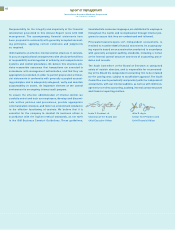IBM 1999 Annual Report Download - page 43
Download and view the complete annual report
Please find page 43 of the 1999 IBM annual report below. You can navigate through the pages in the report by either clicking on the pages listed below, or by using the keyword search tool below to find specific information within the annual report.
41
client/ server —>Internet
In the mists of time (less than a decade ago), the information technology
industry made a big promise. It was called client/server – and it described
seamless connections and communication among all kinds of disparate
computing platforms. It didn’t happen. The promise of “any client to any
server” proved to be far more costly and difficult to implement than anyone
expected. Then, along came the Internet and its open communications
protocols. Almost before we noticed, the long-awaited promise of any-to-any
connectivity materialized – not just among computers, but also among the
people and the enterprises that use them.
big iron —>strong iron
How big are mainframes these days? Smaller than you might think, and
far more powerful than just a few years ago. Recast in the Net world
as enterprise servers, they are about the size of a refrigerator, but nearly
30 times more powerful — as measured in MIPS (millions of instructions
per second) — than just five years ago. And enterprises turning into
e-businesses are finding more value for these powerful servers than ever
before, using them both to host existing systems and applications, and
to integrate those with their new online offerings for customers,
suppliers and employees.
hard drives —>microdrives
IBM makes, and sells, a lot of hard disk drives, many to our competitors
in the PC market. (We’re flattered that they want to pay us for better
hardware.) We’ve also been shipping our tiny-but-powerful 340-megabyte
Microdrive to such customers as Kodak, Samsung, Hitachi and other leaders
in the consumer electronics field. Just a little over an inch square, the
Microdrive can hold 1,000 digital compressed photos, six hours of CD-quality
music, or the equivalent of 300 novels.
trading hours —>friction-free markets
The closing bell says it’s time for people to go home. But their money wants
to hang out and play some more. Pure demand, unhindered by distance or
time differences, can set prices on the Web while we sleep, and sellers don’t
need to wait for a phone call or a fax to hear from the market. Online broker-
ages and computerized exchanges already do big business in after-hours
trading, and other marketplaces – for parts, supplies, services, you name it –
are starting to follow suit.
e-businesses —>e-marketplaces
Today, the company. Tomorrow, the industry. Once a business e-enables its
operations, it can find itself in new terrain, where all its competitors and
customers are also operating as e-businesses. At that point, “buy, sell, trade
online” doesn’t apply just to stocks and bonds, but to every transaction in
which an enterprise engages. Airlines and hotels are already auctioning
off unsold seats and rooms via Web sites; universities are accepting online
bids for tuition to fulfill their enrollment targets. And consolidators and
infomediaries are bringing all parties together, with up-to-the-minute bids,
prices and availability information. Markets become more liquid and efficient,
and obstacles like time and geography become so… 20th century.
profit (n.,v.)
The market valuations of many dot-coms
notwithstanding, still a valid measure of
business success.
stickiness (n.; from sticky, adj.)
In the Web world, sticky is good. A
sticky site is one that attracts and keeps
users. To make a site stickier, its creators
may add personalization elements,
online communities and discussion areas,
user feedback, and extensive links.
vortal (n.)
Vertical portal. It provides all the features
of a “portal” (a Web site for a general
audience, with its own content and links
to other sites – like Yahoo!), but for a
specific audience, such as expectant
parents, fly fishers, or steelmakers and
their customers. Software developers,
for example, go to sites like IBM’s
developerWorks (www.ibm.com/developer)
to find resources, code and tools, and to
swap ideas within a like-minded community.
wallet (n.)
A small software program that resides
on your computer or a server, allowing you
to e-shop till you drop. The wallet usually
consists of encryption software that can
hold your already-submitted payment
information (such as credit card or online
account), a digital certificate to identify
and protect you, and even the address
where you’d like your purchase sent.
Wallets speed the process and eliminate
buyer frustration, thereby increasing sales.
a brief history of e [then —>now]



